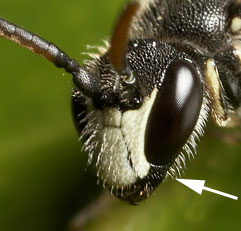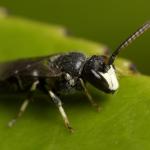The species is found throughout much of England and Wales, though scarce in northern England and south-west Scotland. It is found sporadically in Ireland, with a few records from Waterford, Wexford, Wicklow and Kilkenny. It has also been reported from the Isle of Man. There are records from the larger of the Channel Islands: Alderney, Guernsey, Herm, Jersey and Sark. This is a locally common bee.
The species is very widely distributed throughout much of Europe, from Fennoscandia to Iberia and east to Crete, Turkey and European Russia. It is also known from western Asia (Azerbaijan; Iran) and North Africa (Morocco) (Koster, 1986; Ascher & Pickering, 2012). The species is apparently adventive in eastern North America, with records from southern Ontario, Illinois, Ohio and New York (Ascher & Pickering, 2012).
The species is not regarded as scarce or threatened.
 The male has sparse, long, pale hairs on its face and a wide malar space (arrowed - the space between the bottom of the eye and the base of the mandible).
The male has sparse, long, pale hairs on its face and a wide malar space (arrowed - the space between the bottom of the eye and the base of the mandible).
Photo: Brian Valentine
This bee is found in many kinds of surroundings, including gardens in towns and cities, sand pits, quarries and on the coast (sand dunes, shingle forelands and the bases of cliffs).
Univoltine; late May to the beginning of September.
The bee is an opportunist, nesting in many kinds of naturally occurring niches of suitable diameter. These include burrows in masonry, rocks and sandbanks. In mainland Europe it has been reared from burrows in dead stems and wood and may use these in the British Isles too.
White bryony, mock-orange, biting stonecrop, English stonecrop, bramble, silverweed, rose, spurge, bloody crane’s-bill, ground-elder, water-dropwort, wild parsnip, hogweed, wild carrot, field bindweed, dodder, thyme, speedwell, hedge veronica, sheep’s-bit, creeping thistle, greater knapweed, goldenrod, mayweed, autumn squill and onion.
No data available.
2018





